When it comes to getting more online donations through your WordPress website, I’ve found that it all comes down to a few best practices.
By giving potential donors the information they need and removing potential roadblocks, you can easily raise more money from donations. This can help you keep up with rising costs, expand your reach, and achieve new goals.
Luckily, this is really easy to do by making a few key changes to your WordPress donation forms. And today, I’ll share the most important donation form best practices that I’ve discovered can seriously boost donations in WordPress.
Note: This is a guest post by Thomas Griffin, the president of Charitable and WP Simple Pay, two of the best plugins for accepting donations in WordPress. This is an expert column that we publish where we invite a WordPress expert to share their experiences with our readers.
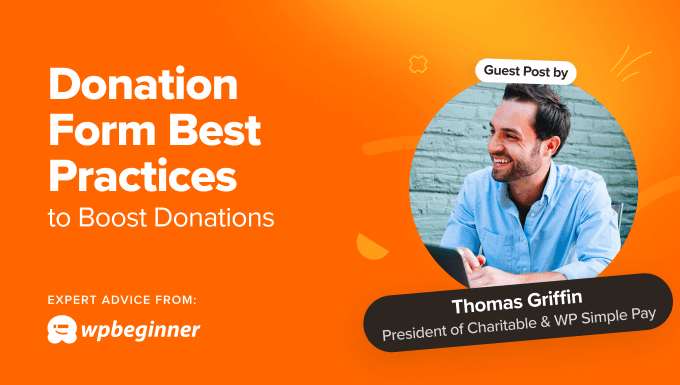
I will cover quite a few topics in this post. Here’s a handy list so you can jump to the section you are most interested in:
- Choose a WordPress Plugin Designed for Donations
- Make the Donation Form Easy to Find
- Explain How the Donations Will Make a Difference
- Keep the Donation Form Simple
- Allow Donors to Give Securely Using Their Preferred Method
- Allow Donors to Choose Preset Donation Amounts
- Allow Recurring Donations
- Gratefully Acknowledge the Donation
- Make It Easy to Share Your Donation Form
1. Choose a WordPress Plugin Designed for Donations
Because there’s so much involved in optimizing a donation form for conversions, my first piece of advice is to choose a WordPress plugin specifically designed for donations.
This won’t just save you time and effort so you can focus on your mission, but these plugins are also designed from the ground up to optimize conversions and boost your donations.
The best donation plugins integrate with secure payment gateways to protect your donors and gain their trust. They also offer the features you need to use the best practices I will outline below.
For many organizations, WP Simple Pay is an excellent choice. It’s one of the best credit card processing plugins for WordPress, includes user-friendly donation features, and its drag-and-drop form builder offers pre-made templates custom-designed for donation pages.
Other organizations may prefer a dedicated donation and fundraising plugin for WordPress. I recommend Charitable because it includes a lot of different features for collecting donations and creating complete fundraising campaigns.

While there are free versions of these plugins to help you get started, you’ll need the premium tools for features such as recurring donations. As a bonus, you won’t be charged any transaction fees, so you can make the most of the money given.
2. Make the Donation Form Easy to Find
It goes without saying that you won’t get many donations if no one can find your form. Making your donation form visible and discoverable should be your first priority.
You can simply start by adding your donation page to your navigation menu in WordPress. Better still, I recommend adding a button to your nav menu and using a contrasting color that stands out.
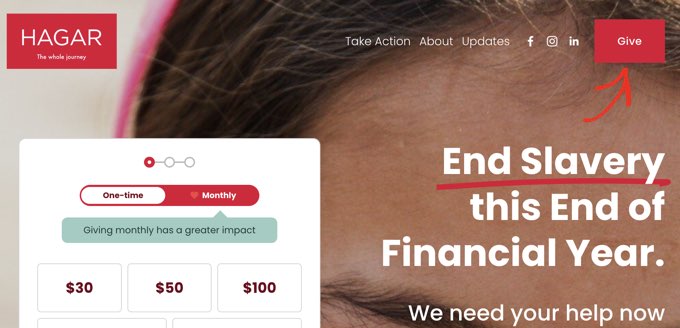
Make sure you use clear button text that can be understood at a glance. Some popular examples include ‘Donate’, ‘Donate Now’, ‘Give Now’, and ‘Support Us’.
You should also include the donation form with other important links in your website’s footer.
At key times of the year, you can make your donation form even more visible using a popup. For example, nonprofits make a huge 25% of their total online donation revenue in December, making it an ideal month for a popup marketing campaign.
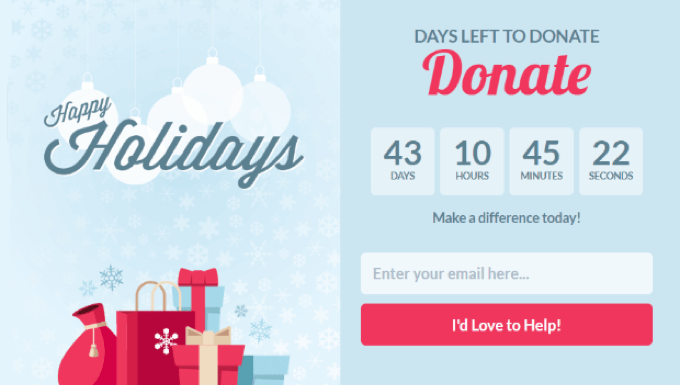
Using a carefully designed popup to promote your donation form at strategic times of the year can boost conversions by 250%.
Before you add a popup to your site, I recommend taking time to read my team’s helpful list of easy tips for nonprofits to boost year-end fundraising with popups.
3. Explain How the Donations Will Make a Difference
Now that a potential donor has landed on your donation page, it’s super important to grab their interest by explaining how their donation will make a difference. Being very specific can reassure potential donors and gain their trust.
Studies show that donors want to know how an organization spends its money before donating, and 63% of millennials research organizations before giving. However, only 4% of donation pages explain how the donations will be used.
The UNICEF donation page does this well. They use a pie chart that illustrates how each dollar is used. This shows that 82 cents go directly to programs, while 13 cents are used to raise awareness, and just 5 cents are used for administration.
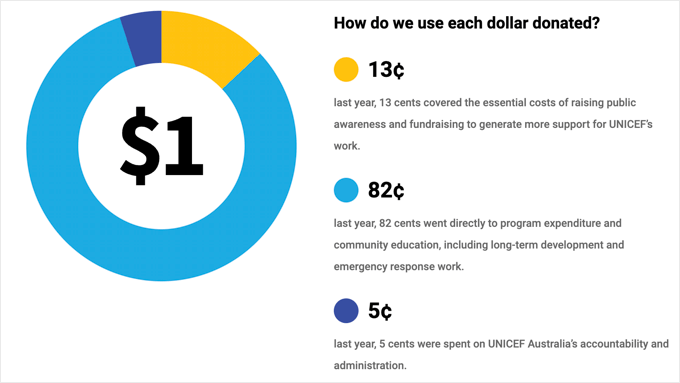
But they don’t just quote figures. They also use compelling storytelling and photography to connect their work with the reader’s emotions and help them visualize the impact of their donation.
Video content allows you to present lots of information without overwhelming your donation page. It can increase conversions by as much as 86% and is easy to consume on mobile devices.

I often remind organizations that a donation page is essentially a specialized landing page and should be optimized like one. It should start with a compelling headline, provide essential information, and end with a clear call to action.
A landing page is a standalone web page created with one focused objective. It leads visitors towards a single action… This is the page’s CTA or call to action.
John Turner – Co-Founder of SeedProd
That’s why I recommend you study John Turner’s expert insights on the anatomy of a high-converting landing page and use these elements on your donation page.
4. Keep the Donation Form Simple
Complex forms can scare users away. If a form looks like it requires a lot of work or asks too many personal questions, then users might be reluctant to complete it.
It’s a good idea to keep the number of fields on your donation form to a minimum. You should only ask for essential information like name, email address, and donation amount, and pre-fill as many fields as possible to make the form easy to complete.
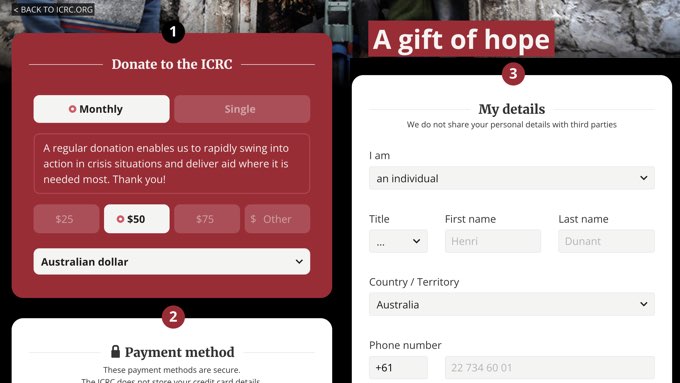
Some users prefer to give anonymously, so make sure fields that ask for a name or contact details are optional. You can also reassure users by stating on the form that you will not share their personal data with third parties.
If you need help creating a simple and effective donation form, then you can follow this guide on how to create a donation form for nonprofit organizations using WordPress.
When you do need to collect a lot of information, the best practice is to create a multi-page form with a progress bar and ask the easiest questions first. This will help the user start to fill out the form without feeling overwhelmed.
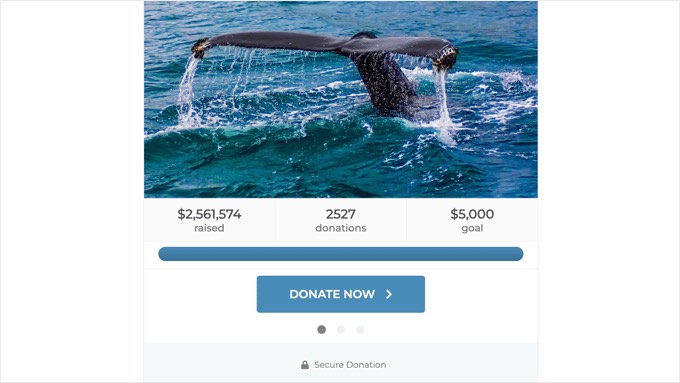
5. Allow Donors to Give Securely Using Their Preferred Method
Users who have decided to give money can become frustrated when you don’t offer their preferred payment method. Removing this sort of friction and inconvenience will ensure they don’t have second thoughts about giving to your cause.
Luckily, top donation plugins integrate with secure payment gateways like PayPal and Stripe. This lets you offer multiple payment methods, ensure safe transactions, and build donor trust.
When you clearly display the payment methods you accept, you demonstrate that you value your donors’ preferences and are committed to secure online transactions.
For example, the UNICEF donation page clearly states that all donations are protected by SSL and lists the payment options they accept, including credit card, PayPal, and Google Pay.
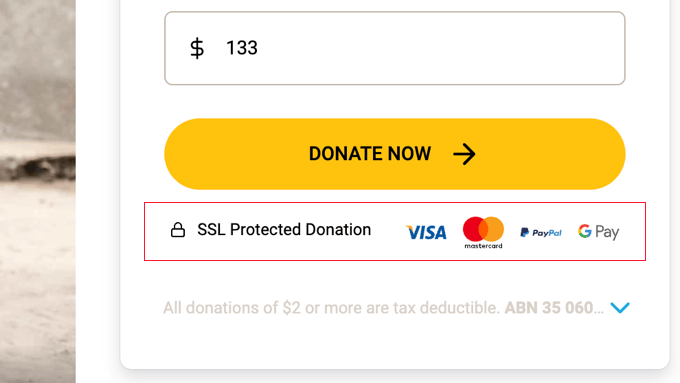
For maximum flexibility, plugins like Charitable also allow donors to use offline payment methods such as checks, bank transfers, and more.
6. Allow Donors to Choose Preset Donation Amounts
You might be surprised to learn that many first-time donors have difficulty knowing how much they should give. This uncertainty can lead to hesitation or even abandonment where the visitor leaves the page without donating.
Offering a few suggested donation amounts makes the choice easier, allowing users to simply click on an amount on the form. You should also allow donors who know how much they want to give to type in the amount.
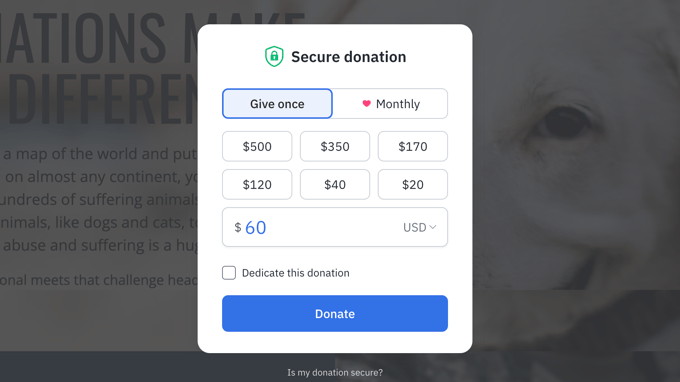
It can also be helpful to show the benefits that different-sized donations make.
For example, the Oxfam donation page breaks down what can be achieved with different amounts.
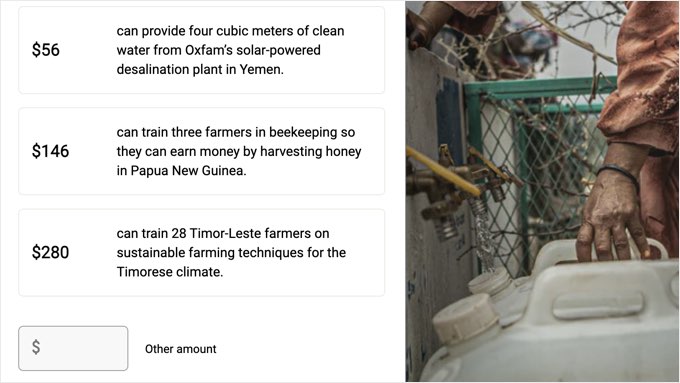
The World Animal Protection donation form does something similar.
When you click on one of the preset amounts, you see a photo and description of what that amount of money can achieve, such as paying for the monthly vet costs for a bear.
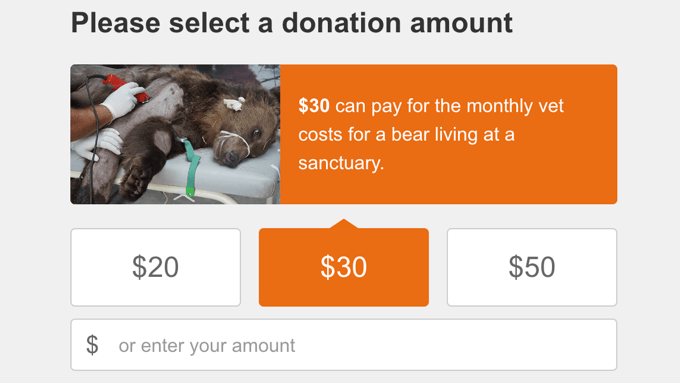
Preset amounts can also encourage larger donations. The Loggerhead Marinelife Center in Florida found their visitor center donations increased 400% when they started suggesting donation amounts.
7. Allow Recurring Donations
Allowing recurring donations on your form can turn a single one-off payment into an ongoing revenue stream. This can provide consistent funding for your long-term projects.
It also makes life easier for donors who want to give on an ongoing basis because any future donations they agree to will be paid automatically.
Let’s look at the math. While the average donation amount for one-time gifts is $121, the average for recurring gifts is just $25 per month. But that $25 is paid multiple times, bringing the average for recurring donations up to $287 each year.
Monthly recurring donations are far more popular than weekly or yearly. Many donation forms keep things simple by offering a one-off donation or ongoing monthly payments.
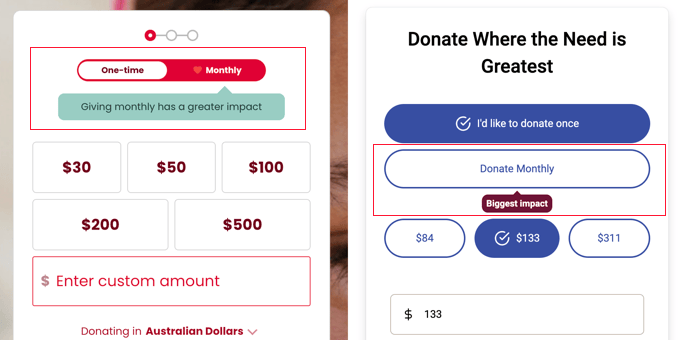
The donation forms above also highlight that the monthly option makes the biggest impact.
You can find step-by-step instructions on how to implement this in this guide on how to create a recurring donation form in WordPress.
8. Gratefully Acknowledge the Donation
Personalized thank-you messages and confirmation emails make donors feel appreciated. One report found that first-time donors are 80% more likely to give again if you send a personalized acknowledgment.
Both WP Simple Pay and Charitable can easily redirect a user to a thank you page after they make a donation. This is a page where you can express your appreciation and explain the impact the donor’s gift has made.

They also allow you to send a thank you email.
In my experience, showing your appreciation like this can quickly turn a one-time donor into a lifetime supporter. You can also take the opportunity to show the donor further ways they can support your organization, such as by volunteering or subscribing to your newsletter.
9. Make It Easy to Share Your Donation Form
One of the best ways a donor can help after giving to your organization is to share your donation form with their friends, family, and co-workers.
This encourages like-minded people in their network to think of making a donation. Plus, studies have found that each share can raise an additional 18% of the gift that was made.
The World Bicycle Relief organization does this by using an effective, multi-pronged approach to encourage donors to share their donation form.
First, you have the option to give the donation in honor of someone else. This allows you to send an e-card or printed card to that person, which may prompt them to match the donation.
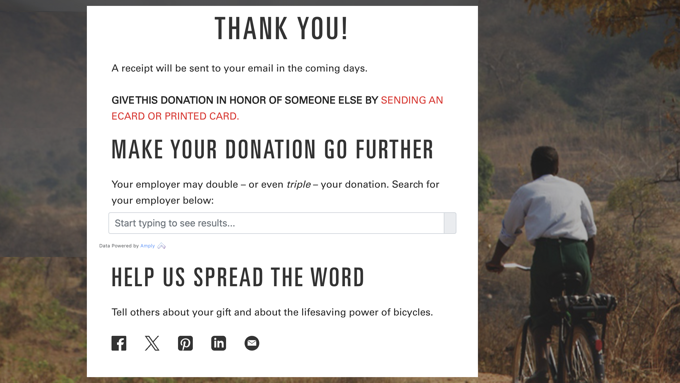
They also allow you to search for your employer to see if they’ve submitted a policy to match your donation. This could instantly double the donation.
Third, they encourage donors to spread the word by clicking social share buttons.
Finally, at the bottom of the thank you page, they give you a fourth option: fundraising. Donor-driven campaigns are very effective, allowing nonprofits to recruit 300 new donors on average.
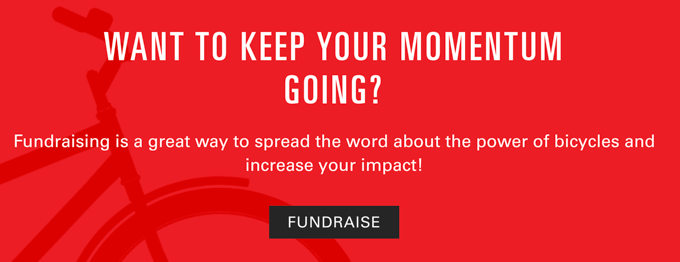
For details on how to do this, you can see this guide on how to create peer-to-peer fundraising in WordPress.
I hope this article helped you understand donation form best practices to boost donations in WordPress. You may also want to read this guide on how to add a Stripe donate button (with a recurring option) or this expert pick of the best crowdfunding plugins for WordPress.
If you liked this article, then please subscribe to our YouTube Channel for WordPress video tutorials. You can also find us on Twitter and Facebook.
The post 9 Top Donation Form Best Practices to Boost Donations in WordPress first appeared on WPBeginner.
from WPBeginner https://ift.tt/hqca6bH




0 Comments